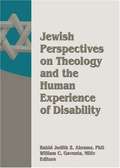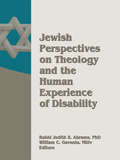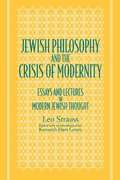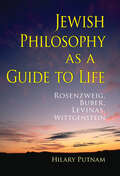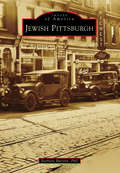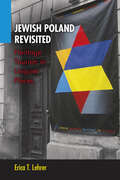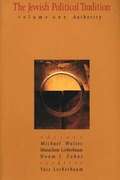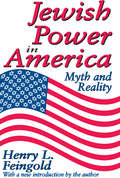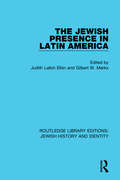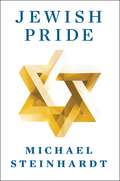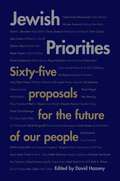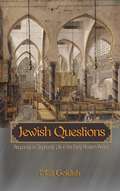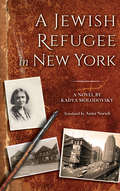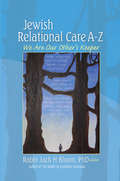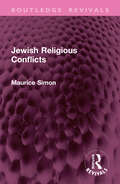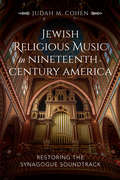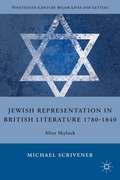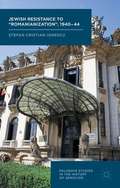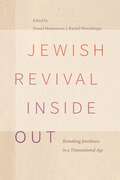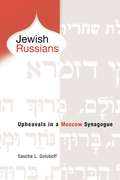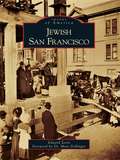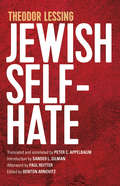- Table View
- List View
Jewish Perspectives on Theology and the Human Experience of Disability
by Judith Z. Abrams William C. GaventaFew people are untouched by the issue of disability, whether personally or through a friend or relative. Jewish Perspectives on Theology and the Human Experience of Disability shares moving insights from around the world and across the broad spectrum of Judaism on how and why the Jewish community is incomplete without the presence and participation of the disabled. Authors representing each of the three main movements of Judaism--Orthodox, Conservative, and Reform--examine theology, scripture, ethics, practical theology, religious education, and personal experience to understand and apply the lessons and wisdom of the past to issues of the present.
Jewish Perspectives on Theology and the Human Experience of Disability
by William GaventaA re-examination of Jewish scripture and teachings about disabilitiesFew people are untouched by the issue of disability, whether personally or through a friend or relative. Jewish Perspectives on Theology and the Human Experience of Disability shares moving insights from around the world and across the broad spectrum of Judaism on how and why the Jewish community is incomplete without the presence and participation of the disabled. Authors representing each of the three main movements of Judaism-Orthodox, Conservative, and Reform-examine theology, scripture, ethics, practical theology, religious education, and personal experience to understand and apply the lessons and wisdom of the past to issues of the present.Authors from Israel, the United States, the United Kingdom, and Australia reflect on their theological understandings of specific disabilities and on disability as a whole. Jewish Perspectives on Theology and the Human Experience of Disability re-examines tradition, teachings, and beliefs to shatter stereotypes of Judaism and common interpretations of scripture. This unique book addresses several disabilities (blindness, deafness, intellectual disabilities, autism, learning disabilities), and a wide range of topics, including human rights and disabilities, Jewish laws concerning niddah, misconceptions about disabilities in the Hebrew Bible, Jewish community programs to include people with disabilities, and the need to educate American Jews about Jewish genetic diseases.Jewish Perspectives on Theology and the Human Experience of Disability examines: three methods that allow Jews who are blind to participate in the Torah service the spiritual needs of people with learning disabilities the attitude of Jewish Law toward marriage and parenthood on people with intellectual disabilities how the rabbis of the Mishnah incorporated Greco-Roman beliefs about the connections between hearing, speech, and intelligence into Jewish law a sampling of opinions issued on matters concerning disabilities by the Responsa Committee of the Central Conference of American Rabbis how the Jewish sages have made participation by people with disabilities possible and much moreJewish Perspectives on Theology and the Human Experience of Disability also includes reviews of Judaism and Disability: Portrayals in Ancient Texts from the Tanach through the Bavil and Disability in Jewish Law, as well as comprehensive resource collections. This book is an essential read for clergy and lay leaders involved in the support of people with disabilities, for the families of people with disabilities, and for anyone working with the disabled.
Jewish Philosophy And The Crisis Of Modernity: Essays And Lectures In Modern Jewish Thought
by Leo Strauss Kenneth Hart GreenExplores the impact on Jews and Judaism of the crisis of modernity, analyzing modern Jewish dilemmas and providing a prescription for their resolution.
Jewish Philosophy as a Guide to Life: Rosenzweig, Buber, Levinas, Wittgenstein (The\helen And Martin Schwartz Lectures In Jewish Studies)
by Hilary PutnamAn &“engagingly personal&” exploration of Rosenzweig, Buber, Levinas, and the relationship between philosophy and religion (Times Literary Supplement). In this book, distinguished philosopher and practicing Jew Hilary Putnam questions the thought of three major Jewish philosophers of the twentieth century—Franz Rosenzweig, Martin Buber, and Emmanuel Levinas—to help him reconcile the philosophical and religious sides of his life. An additional presence in the book is Ludwig Wittgenstein, who, although not a practicing Jew, thought about religion in ways that Putnam juxtaposes to the views of Rosenzweig, Buber, and Levinas. Putnam explains the leading ideas of each of these great thinkers, bringing out what, in his opinion, constitutes the decisive intellectual and spiritual contributions of each of them. Although the religion discussed is Judaism, the depth and originality of these philosophers, as incisively interpreted by Putnam, make their thought nothing less than a guide to life.&“One of the most distinguished analytical philosophers, Putnam has written an unusual book that uses the thought of key philosophers to find points of commonality between the religious and the philosophical.&” —Library Journal
Jewish Pittsburgh (Images of America)
by Barbara BurstinBy the mid-19th century, Jews from German lands began settling in Pittsburgh, later to be followed by Jews from the Russian and Austro-Hungarian Empires and Romania. They founded businesses and organizations such as Giant Eagle, Kaufmann's Department Store, Montefiore Hospital, the Pittsburgh Playhouse, the Civic Light Opera, and the Pittsburgh Pirates. Sophie Masloff became the first woman and the first Jew to serve as mayor, and civic reformer and lawyer A. Leo Weil, philanthropist Leon Falk Jr., and social justice crusader Florence Reizenstein all had schools named after them. From Allegheny City and "the Hill" to Squirrel Hill and the East End, the Jewish population preserved its distinct core community and contributed to its adopted city in multiple ways. Today, it numbers more than 40,000, and their story is one of grit, determination, risk taking, hard knocks, and no small measure of success.
Jewish Poland Revisited: Heritage Tourism In Unquiet Places (New Anthropologies of Europe)
by Erica T. LehrerSince the end of Communism, Jews from around the world have visited Poland to tour Holocaust-related sites. A few venture further, seeking to learn about their own Polish roots and connect with contemporary Poles. For their part, a growing number of Poles are fascinated by all things Jewish. Erica T. Lehrer explores the intersection of Polish and Jewish memory projects in the historically Jewish neighborhood of Kazimierz in Krakow. Her own journey becomes part of the story as she demonstrates that Jews and Poles use spaces, institutions, interpersonal exchanges, and cultural representations to make sense of their historical inheritances.
Jewish Poland—Legends of Origin: Ethnopoetics and Legendary Chronicles (Raphael Patai Series in Jewish Folklore and Anthropology)
by Haya Bar-ItzhakThe first appearance of Jews in Poland and their adventures during their early years of settlement in the country are concealed in undocumented shadows of history. What survived are legends of origin that early chroniclers, historians, writers, and folklore scholars transcribed, thus contributing to their preservation. According to the legendary chronicles Jews resided in Poland for a millennium and developed a vibrant community. <P><P> Haya Bar-Itzhak examines the legends of origin of the Jews of Poland and discloses how the community creates its own chronicle, how it structures and consolidates its identity through stories about its founding, and how this identity varies from age to age. Bar-Itzhak also examines what happened to these legends after the extermination of Polish Jewry during the Holocaust, when the human space they describe no longer exists except in memory. For the Polish Jews after the Holocaust, the legends of origin undergo a fascinating transformation into legends of destruction. <P><P> Jewish Poland-Legends of Origin brings to light the more obscure legends of origin as well as those already well known. This book will be of interest to scholars in folklore studies as well as to scholars of Judaic history and culture.
The Jewish Political Tradition, Volume 1: Authority
by Michael Walzer Yair Lorberbaum Menachem Lorberbaum Noam Zohar Noam J. ZoharThis book launches a landmark four-volume collaborative work exploring the political thought of the Jewish people from biblical times to the present. The texts and commentaries in Volume I address the basic question of who ought to rule the community. The contributors--eminent philosophers, lawyers, political theorists, and other scholars working in different fields of Jewish studies--discuss the authority of God, the claims of kings, priests, prophets, rabbis, lay leaders, and gentile rulers during the years of the exile, and issues of authority in the modern state of Israel.
Jewish Population and Identity: Concept and Reality (Studies of Jews in Society #1)
by Sergio DellaPergola Uzi RebhunThis book examines the fundamentals of Jewish demography and sociology around the world. It is not only concerned with documenting patterns of population change but also with an intriguing and ever-present issue like "Who is a Jew?" The latter transcends the limits of quantitative assessment and deeply delves into the nature, boundaries, and quality of group identification. A growing challenge is how to bridge between concept – related to ideals and theory – and reality – reflecting field research. Divided into six sections, the book discusses historical demography, immigration and settlement, population dynamics, social stratification and economy, family and Jewish identity in the U.S., and Jewish identity in Israel. The volume represents the dynamic and diverse nature of the study of world and local Jewish populations. It shows how that field of study provides an important contribution to the broader and now rapidly expanding study of religious and ethnic groups. Scholars in disciplines such as history, geography, sociology, economics, political science, and especially demography follow and analyze the social and cultural patterns of Jews in different places around the globe, at various times, and from complementary perspectives. They make use of historical sources that have recently become accessible, utilize new censuses and surveys, and adopt advanced analytical methods. While some of their observations attest to consistency in the Jews’ demographic and identificational patterns, others evolve and ramify in new directions that reflect general processes in the areas and societies that Jews inhabit, internal changes within Jewish communities, and intergenerational trends in personal preferences of religious and ethnic orientations. This volume brings together contributions from scholars around the world and presents new and updated research and insights.
Jewish Power in America: Myth and Reality
by Henry FeingoldJewish political power exists as a separate agency in the American polity, but before it can be determined whether it is inordinate, historian Henry L. Feingold declares that it first needs to be identified and defined. Jewish power is not associated with military armaments as with a sovereign state like Israel. Nor is it personal power. There are many influential Jews today who have raised huge sums for office seekers, but there are none whose use of financial resources was inordinate. With the exception of an abiding concern with the security of Israel, there are no overriding public policy concerns that differentiate Jewish voters from the informed, educated segment of the American electorate.Feingold acknowledges that American Jews do have political power. But what kind is it, and how does it compare to the power exercised by other ethnic and interest groups that thrive in the American polity? The basic charge of those who have raised the alarm about Jewish power—that it is used conspiratorially against the national interest—is addressed and repudiated. This book addresses the question of Jewish power by examining five recent major instances, beginning with the New Deal, when the play of Jewish power, or power exercised by Jews, was evident.The engagement of American Jewry in the political process is amply documented by survey research and evidenced by the disproportionate number of Jewish office holders on all levels of government. It can be traced in some measure to its relationship to European Jewish migration and to the inherent activism of the political left. The work presents the reader with a broadly comprehensive and highly informative picture of American Jewish participation in the American polity.
The Jewish Presence in Latin America (Routledge Library Editions: Jewish History and Identity)
by Judith Laikin Elkin Gilbert MerkxOriginally published in 1987, this collection of essays is a major contribution toward developing a realistic picture of the Latin American Jewish communities in the late 20th Century. The book will be of interest to students of comparative studies, Jewish studies and Latin American studies and responds to the need to learn more about the Jewish communities of Latin America, both as a fragment of the Jewish diaspora and as an element in the economic and social life of the continent.
Jewish Pride
by Michael SteinhardtMichael Steinhardt left a stellar career on Wall Street and spent the next three decades launching revolutionary philanthropic programs like Birthright Israel and OneTable that offer a proud, rich future for the next generation of secular American Jews.What are the keys to a proud Jewish life? Part memoir, part manifesto, Michael Steinhardt&’s Jewish Pride offers a compelling vision for a rich, rewarding future for Jews in America and around the world. From his middle class beginnings in Brooklyn to a spectacular Wall Street career, Steinhardt understood that apathy and assimilation were threatening the Jewish future in America. Meanwhile established Jewish institutions were failing in the urgent task of strengthening secular Jewish identity. Using his own capital and the wisdom and connections he&’d gained in his successful business career, Steinhardt recruited partners, focused on data and results, and even got the Israeli government to help launch the revolutionary Birthright program. By turns provocative, inspiring, revealing, and outright hilarious, Jewish Pride captures its author&’s unique personality and outlook and offers honest talk about the Jewish world today, along with a bold prescription for revitalizing Jewish life in the future.
Jewish Priorities: Sixty-Five Proposals for the Future of Our People
by David HazonyAn unprecedented, large-scale collection of timely and provocative essays from a wide range of Jewish thought leaders that aims to start a global conversation among Jews about their future as a people.&“…a mind-expanding look at how Judaism can survive and thrive in the 21st century.&” –Publishers Weekly Imagine having the entire Jewish people over for dinner—and hosting a raucous, creative, riveting debate about their collective future. Jewish Priorities offers, for the first time, a wide-ranging, ambitious, and genuinely &“pan-Jewish&” conversation. Encompassing more than sixty top authors from around the Jewish world—Israelis and Diaspora writers; younger influencers and veteran opinion leaders; rabbinic and communal leaders, journalists and scholars, and literary and cultural figures, ranging from secular to ultra-Orthodox—each contributor offers a different priority for the Jewish people. In the process, Jewish Priorities captures the tremendous breadth, depth, and passionate commitment that has long defined this unique community in history. These essays are all original and come from some of our greatest luminaries—thought leaders like Natan Sharansky, Dara Horn, Yossi Klein Halevi, Ruth Wisse, Shaul Magid, David Wolpe, Fania Oz-Salzberger, and many more. Their topics vary widely, from Zionism and antisemitism to education and philanthropy; from the Holocaust to Jewish intimacy; from the quest for God to the failure of Jewish institutions, to the best way to study the Torah in an age of viral videos. Jewish Priorities offers an unprecedented snapshot of the cultural, political, and religious currents driving an entire generation of Jews—but also the deepest aspirations and dreams of this beautiful, unique people at a pivotal moment in our history.
Jewish Questions: Responsa on Sephardic Life in the Early Modern Period
by Matt GoldishIn Jewish Questions, Matt Goldish introduces English readers to the history and culture of the Sephardic dispersion through an exploration of forty-three responsa--questions about Jewish law that Jews asked leading rabbis, and the rabbis' responses. The questions along with their rabbinical decisions examine all aspects of Jewish life, including business, family, religious issues, and relations between Jews and non-Jews. Taken together, the responsa constitute an extremely rich source of information about the everyday lives of Sephardic Jews. The book looks at questions asked between 1492--when the Jews were expelled from Spain--and 1750. Originating from all over the Sephardic world, the responsa discuss such diverse topics as the rules of conduct for Ottoman Jewish sea traders, the trials of an ex-husband accused of a robbery, and the rights of a sexually abused wife. Goldish provides a sizeable introduction to the history of the Sephardic diaspora and the nature of responsa literature, as well as a bibliography, historical background for each question, and short biographies of the rabbis involved. Including cases from well-known communities such as Venice, Istanbul, and Saloniki, and lesser-known Jewish enclaves such as Kastoria, Ragusa, and Nablus, Jewish Questions provides a sense of how Sephardic communities were organized, how Jews related to their neighbors, what problems threatened them and their families, and how they understood their relationship to God and the Jewish people.
Jewish Radical Ultra-Orthodoxy Confronts Modernity, Zionism and Women’s Equality
by Inbari, Motti and Vardi, Shaul Motti Inbari Shaul VardiIn Jewish Radical Ultra-Orthodoxy Confronts Modernity, Zionism and Women's Equality, Motti Inbari undertakes a study of the culture and leadership of Jewish radical ultra-Orthodoxy in Hungary, Jerusalem and New York. He reviews the history, ideology and gender relations of prominent ultra-Orthodox leaders Amram Blau (1894–1974), founder of the anti-Zionist Jerusalemite Neturei Karta, and Yoel Teitelbaum (1887–1979), head of the Satmar Hasidic movement in New York. Focussing on the rabbis' biographies, the author analyzes their enclave building methods, their attitude to women and modesty, and their eschatological perspectives. The research is based on newly discovered archival materials, covering many unique and remarkable findings. The author concludes with a discussion of contemporary trends in Jewish religious radicalization. Inbari highlights the resilience of the current generations' sense of community cohesion and their capacity to adapt and overcome challenges such as rehabilitation into potentially hostile secular societies.
A Jewish Refugee in New York: A Novel (The Modern Jewish Experience)
by Kadya Molodovsky“This novel invites the reader inside the mind of a Polish Jewish woman who has recently arrived in New York just after WWII began in Europe.” —Jeffrey Shandler, author of Anne Frank UnboundRivke Zilberg, a twenty-year-old Jewish woman, arrives in New York shortly after the Nazi invasion of Poland, her home country. Struggling to learn a new language and cope with a different way of life in the United States, Rivke finds herself keeping a journal about the challenges and opportunities of this new land. In her attempt to find a new life as a Jewish immigrant in the United States, Rivke shares the stories of losing her mother to a bombing in Lublin, jilting a fiancé who has made his way to Palestine, and a flirtatious relationship with an American “allrightnik.”In this fictionalized journal originally published in Yiddish, author Kadya Molodovsky provides keen insight into the day-to-day activities of the large immigrant Jewish community of New York. By depicting one woman’s struggles as a Jewish refugee in the United States during WWII, Molodovsky points readers to the social, political, and cultural tensions of that time and place.
Jewish Relational Care A-Z: We Are Our Other's Keeper
by Jack H BloomA collection of caregiving tools combining the values of Jewish tradition and self-relations-useful for practitioners of ANY faith!Self-relations, a powerful framework for doing respectful and humane caregiving for oneself and for others is here brought into relationship with Jewish thought. Jewish Relational Care A-Z: We Are Our Other&’s Keeper is an extensive resource for caregiving tools and approaches. Using Jewish tradition and Self-Relations as take-off points, experts from many fields provide insightful perspectives and effective strategies for caregiving.In the language of self-relations each of us is not referred to as a Self. Instead, each of us is more accurately described as a relationship between "selves"-relationship is the basic psychological and religious unit! Jewish Relational Care A-Z: We Are Our Other&’s Keeper sensitively centers on relationships and the healing process, using the understanding that to spark healing in others, a loving, respectful relationship must first be present between every aspect of our "selves." Thirty-six categories of caregiving are comprehensively presented, allowing its use as a helpful resource for any clergy considering any of the included topics. Each author&’s personal reflections, and personal experiences using care tools clearly illustrate how love-respect relationships within oneself can transcend into effective care for others.Jewish Relational Care A-Z: We Are Our Other&’s Keeper provides helpful tools and explores: the use of language as a relational care tool time management for optimum performance for oneself and for others compassion fatigue, the need for self-care, and nurturing your own spiritual and psychological development purposeful visiting as a sacred task silence as an important part of spiritual care the profound difference made in lives through relational listening music as sacred power-a communion between humans and the Divine chanting as an intimate expression of the soul creative ritual in relational healing spontaneous prayer, and its place in relational care relational care with other faiths inside and outside of the community care for those going through divorce care when a pregnancy is unwelcome relational care for sexual orientation and gender identity issues successful caring for those who don&’t care about you dealing with traumatic loss care for those who have sinned sexually fragile relationships care with the healthy aging relational care and retired clergy care for those traumatized by sexual abuse care for the cognitively impaired, mentally ill, and developmentally disabled care for the final moments of life care for the sick and dying care within the grieving processJewish Relational Care A-Z: We Are Our Other&’s Keeper is practical, insightful reading for clergy and caregivers of all denominations, educators, students, and lay people who care about clergy and their work.
Jewish Religious Conflicts (Routledge Revivals)
by Maurice SimonFirst published in 1950, Jewish Religious Conflicts gives an account of the principal cleavages that have taken place within the Jewish people since the close of the Old Testament over questions of religious faith, doctrine and practice. While passing in review the chief sects that have formed themselves during that period, it pays particular attention to the most recent cleavages, those between the ‘orthodox’ and ‘reform’, and between the ‘conservative’ and ‘liberal’ movements, which are dividing the Jewish community. This book will be of interest to students of religion and history.
Jewish Religious Music in Nineteenth-Century America: Restoring the Synagogue Soundtrack
by Judah M. CohenThis study of synagogue music in the United States in the second half of the nineteenth century “sets a high standard for historical musicology” (Musica Judaica).In Jewish Religious Music in Nineteenth-Century America: Restoring the Synagogue Soundtrack, Judah M. Cohen demonstrates that Jews constructed a robust religious musical conversation in the United States during the mid- to late-nineteenth century. While previous studies of American Jewish music history have looked to Europe as a source of innovation during this time, Cohen’s careful analysis of primary archival sources tells a different story. Far from seeing a fallow musical landscape, Cohen finds that Central European Jews in the United States spearheaded a major revision of the sounds and traditions of synagogue music during this period of rapid liturgical change.Focusing on the influences of both individuals and texts, Cohen demonstrates how American Jewish musicians sought to balance artistry and group singing, rather than “progressing” from solo chant to choir and organ. Congregations shifted between musical genres and practices during this period in response to such factors as finances, personnel, and communal cohesiveness. Cohen concludes that the “soundtrack” of nineteenth-century Jewish American music heavily shapes how we look at Jewish American music and life in the first part of the twenty-first century, arguing that how we see, and especially hear, history plays a key role in our understanding of the contemporary world around us. Supplemented with an interactive website that includes the primary source materials, recordings of the music discussed, and a map that highlights the movement of key individuals, Cohen’s research defines more clearly the sound of nineteenth-century American Jewry.
Jewish Representation in British Literature 1780–1840
by Michael ScrivenerDescribing Jewish representation bothby Jews and Gentiles in the British Romantic era, Scrivener integrates popular culture with belletristic writing to explore the wildly varying treatments of stereotypical figures: the pedlar, the moneylender, the Jew's daughter, "la belle juive," the convert, the prophet, the alchemist, and the criminal. "
Jewish Resistance to "Romanianization," 1940–44 (Palgrave Studies in the History of Genocide)
by Stefan Cristian IonescuIonescu examines the process of economic Romanianization of Bucharest during the Antonescu regime that targeted the property, jobs, and businesses of local Jews and Roma/Gypsies and their legal resistance strategies to such an unjust policy.
Jewish Revival Inside Out: Remaking Jewishness in a Transnational Age (Raphael Patai Series in Jewish Folklore and Anthropology)
by Asher Biemann Shaul Magid Ruth Ellen Gruber Daniel Monterescu Sara Zorandy Geneviève Zubrzycki Zvi Gitelman Hannah Tzuberi Lucine Endelstein Nissim Leon Rachel Werczberger Shlomo Guzmen-Carmeli Cara Rock-Singer Michael Paley Jonathan BoyarinAgainst the gloomy forecast of "The Vanishing Diaspora", the end of the second millennium saw the global emergence of a dazzling array of Jewish cultural initiatives, institutional modalities, and individual practices. These "Jewish Revival" and "Jewish Renewal" projects are led by Jewish NGOs and philanthropic organizations, the Orthodox Teshuva (return to the fold) movement and its well-known emissary Chabad-Lubavitch Hasidism, and alternative cultural initiatives that promote what can be termed "lifestyle Judaism." This range between institutionalized revival movements and ephemeral event-driven projects circumscribes a diverse space of creative agency, which calls for a bottom-up empirical analysis of cultural creativity and the re-invention of Jewish tradition worldwide. Indeed, the trope of a "Jewish Renaissance" has become both a descriptive category of an increasingly popular and scholarly discourse across the globe, and a prescriptive model for social action. This volume explores the global transformations of contemporary Jewishness, which give renewed meaning to identity, tradition, and politics in our post secular world.
Jewish Russians: Upheavals in a Moscow Synagogue
by Sascha L. GoluboffThe prevalence of anti-Semitism in Russia is well known, but the issue of race within the Jewish community has rarely been discussed explicitly. Combining ethnography with archival research, Jewish Russians: Upheavals in a Moscow Synagogue documents the changing face of the historically dominant Russian Jewish community in the mid-1990s. Sascha Goluboff focuses on a Moscow synagogue, now comprising individuals from radically different cultures and backgrounds, as a nexus from which to explore issues of identity creation and negotiation. Following the rapid rise of this transnational congregation—headed by a Western rabbi and consisting of Jews from Georgia and the mountains of Azerbaijan and Dagestan, along with Bukharan Jews from Central Asia—she evaluates the process that created this diverse gathering and offers an intimate sense of individual interactions in the context of the synagogue's congregation.Challenging earlier research claims that Russian and Jewish identities are mutually exclusive, Goluboff illustrates how post-Soviet Jews use Russian and Jewish ethnic labels and racial categories to describe themselves. Jews at the synagogue were constantly engaged in often contradictory but always culturally meaningful processes of identity formation. Ambivalent about emerging class distinctions, Georgian, Russian, Mountain, and Bukharan Jews evaluated one another based on each group's supposed success or failure in the new market economy. Goluboff argues that post-Soviet Jewry is based on perceived racial, class, and ethnic differences as they emerge within discourses of belonging to the Jewish people and the new Russian nation.
Jewish San Francisco (Images of America)
by Edward Zerin Dr Marc DollingerIn San Francisco, the "instant city" of the gold rush days, Jews were pioneers among pioneers. Some came as immigrants directly from Europe, others as resettled adventurers from the East Coast, and still others as scions of southern Sephardic families. Out of this mixed multitude emerged a community with synagogues and institutions to care for the needy and the sick, along with a dignified social fabric. New immigrants following the Russian pogroms of 1883 were absorbed, and the ashen ruins from the 1906 earthquake were rebuilt. The city's cultural treasures and social needs were enriched, and the city's Jews were nurtured by civic commitments. Today's 70,000 San Francisco Jews, standing upon the shoulders of pioneering giants, continue to build and rebuild.
Jewish Self-Hate
by Theodor LessingThe diagnosis of Jewish self-hatred has become almost a commonplace in contemporary cultural and political debates, but the concept’s origins are not widely appreciated. In its modern form, it received its earliest and fullest expression in Theodor Lessing’s 1930 book Der jüdische Selbsthaß. Written on the eve of Hitler’s ascent to power, Lessing’s hotly contested work has been variously read as a defense of the Weimar Republic, a platform for anti-Weimar sentiments, an attack on psychoanalysis, an inspirational personal guide, and a Zionist broadside. This new edition makes a seminal text in Jewish thought accessible to English readers for the first time.
